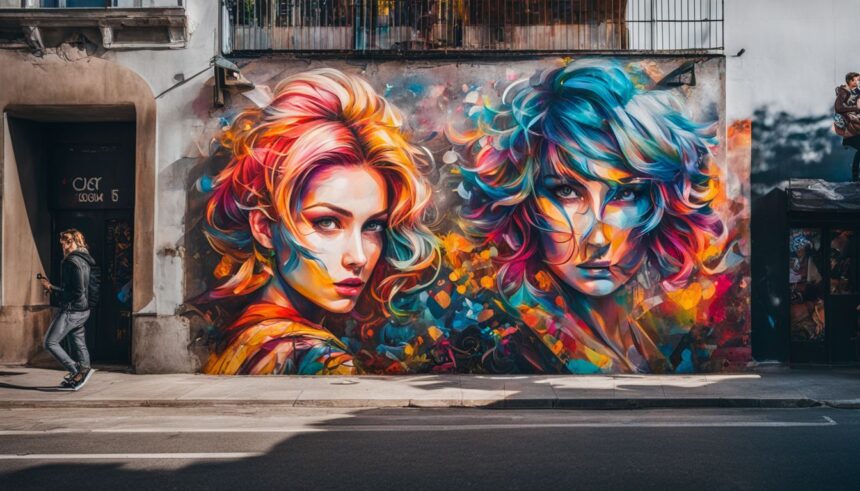Art has this incredible ability to bridge gaps between vastly different cultures and viewpoints from all corners of the world. The journey taken by contemporary art movements is a testament to this, moving effortlessly across geographic lines to weave together a rich mosaic of global interactions.
This universal language of creativity opens up avenues for artists everywhere to share their unique visions and stories with the world, contributing to a dynamic international art scene that’s vibrant and ever-evolving.
Such exchanges don’t just add depth to individual artistic practices; they also foster a sense of mutual understanding among diverse communities. Our exploration into “Art Beyond Borders: Global Perspectives on Contemporary Art Movements” seeks to shine a light on the complex network of cross-cultural influences that mold today’s art.
Leveraging our extensive experience engaging with and studying global art dialogues—including insights gleaned from notable works like “Art Beyond Borders“—we bring a seasoned perspective on how historical milestones such as the Cold War have opened doors for artistic exchanges across different political landscapes.
We pride ourselves on pinpointing those pivotal moments when art breaks free from its immediate surroundings to enter the global stage. Join us as we navigate through this exciting terrain where art knows no bounds, reminding us all that at its core, creativity seeks connection above everything else.
Key Takeaways
- Art exchanges during the Cold War between the Soviet Bloc and Western countries helped artists from different political systems share ideas and styles, despite strict rules.
- Global art movements have broken down geographical boundaries, leading to collaborations among artists worldwide. This blending of cultures enriches contemporary art with diverse perspectives.
- The international art market provides a platform for various cultural expressions to meet. Artists use this space not just for selling their work but also for showcasing diverse artistic traditions.
- Visual contagions in art show how creative ideas spread across borders quickly. These influences create a new wave of creativity that resonates globally.
- Through exploring art beyond borders, people can understand and appreciate global interactions within the contemporary art scene. This fosters greater empathy and interconnectedness among different cultures.
The Cold War and Art Exchange
During the Cold War, art exchange thrived within the Soviet Bloc and between the East and West.
Interactions within the Soviet Bloc
We explore how artists within the communist Europe shared ideas and influenced each other’s work. Many countries in the Soviet bloc had strict rules about what kind of art could be made.
Despite this, artists found ways to exchange their creative thoughts and techniques. They sent letters, shared sketches, and sometimes met in secret. This helped them learn from one another and keep creating new art.
Artistic interactions in communist Europe were not just about sharing styles; they also helped spread messages of hope and resistance. In places where freedom of speech was limited, art became a powerful way to express feelings and criticize government policies.
Some artists used symbols or coded messages that only those living under similar conditions could understand. This built a sense of community among artists across borders, showing how creativity can flourish even in tough times.
Interactions between the East and West
During the Cold War, artists from the East and West engaged in artistic interactions that resonated globally. The book “Art Beyond Borders” delves into these cross-cultural exchanges between 1945 and 1989, offering a fascinating insight into how art bridged ideological divides.
This exploration of cultural intersections sparks an appreciation for the diverse perspectives that emerged during this era. It’s intriguing to note how these artistic dialogues transcended geographical boundaries and contributed to the ever-evolving landscape of contemporary art.
The exchange of art between the Soviet bloc and the West during this period is particularly captivating as it speaks to the power of creativity in fostering connections amidst political tensions.
ALSO READ: Afrobeat Music Trends: History, Streaming, Challenges and Breakthrough(Opens in a new browser tab)
The Globalization of Art Movements
The global art market influences contemporary art. Art reflects diverse perspectives influenced by geopolitical factors in the world.
Geopolitical influences on art
Geopolitical influences play a significant role in shaping art across the world. The exchange of art between the Soviet bloc and the West during the Cold War era has left an indelible mark on contemporary artistic expressions.
Global art movements are reshaping cultural interactions, creating a rich tapestry of diverse perspectives that influence artists worldwide. These influences have contributed to a visual history of international tastes, reflecting the complexities and ever-evolving nature of the world of art.
The book “Art Beyond Borders” presents meticulous analyses of artistic interactions within communist Europe and with the West between 1945 and 1989. Additionally, Surrealism Beyond Borders redraws Surrealism’s map beyond history, geography, and nationality.
International art market
The international art market is a vibrant space where art from different cultures and traditions meets. It’s not only about buying and selling; it’s also an opportunity to explore diverse artistic expressions.
Artists draw influences from global art movements to create their work, making the market a rich tapestry of cultures and perspectives. This broadens our understanding of contemporary art as we navigate through exhibitions showcasing artworks spanning across geographical boundaries.
Contemporary artists are seeking more than just recognition; they aim to connect with audiences worldwide, sparking conversations that transcend borders. They embark on a journey through the international art market, unlocking the secrets of cultural exchange while embracing the ever-evolving world of contemporary art.
The global platform provided by the international art market offers artists an ideal canvas for expressing diverse narratives, and fostering cross-cultural connections in ways that go beyond traditional bounds.
Diverse perspectives in contemporary art
Artists draw influences from global art movements to create their work. The exchange of art between the Soviet bloc and the West during the Cold War era is explored in the book “Art Beyond Borders”.
The globalization of contemporary art is creating a rich tapestry of diverse perspectives. The story of Surrealism in Aleppo, where a group of poets and artists took up automatism, is explored in an essay by Anneka Lenssen.
A visual history of international tastes of a certain elite consumer of art images is depicted in the book “Art Beyond Borders”.
Contemporary art has transcended geographical boundaries, embracing global art movements that reflect diverse cultural interactions. This interplay between various traditions creates an ever-evolving realm for artistic expression; for instance, the exhibition catalog “Surrealism Beyond Borders” redraws the map of Surrealism beyond geography and nationality.
Breaking Down Geographical Boundaries
Geographical boundaries in art are being broken through cross-border artistic collaborations and transnational art exchange. Visual contagions in art are spreading, connecting artists from diverse cultures.
Crossborder artistic collaborations
Artists from different countries collaborate to create unique artworks that blend their diverse perspectives and cultural influences. Artistic collaborations across borders promote the exchange of ideas, techniques, and artistic expressions.
International art movements inspire cross-border collaborations, shaping a rich tapestry of global creativity. The book “Art Beyond Borders” delves into the transnational art exchange during the Cold War era, shedding light on the powerful impact of cross-cultural artistic interactions in shaping contemporary art.
Contemporary artists draw influences from global art movements to enrich their work with diverse cultural elements and innovative approaches. Crossborder artistic collaborations transcend geographical boundaries, creating a dynamic fusion of traditions and styles that captivate audiences worldwide.
Transnational art exchange
Artists draw inspiration from global art movements to create their work. The exchange of art between the Soviet bloc and the West during the Cold War era is explored in the book “Art Beyond Borders.” Our exploration reveals how this transnational art exchange influenced diverse perspectives in contemporary art, creating a rich tapestry of cultural interactions.
This artistic globalization transcended geographical boundaries, leading to cross-border collaborations and visual contagions in art.
The story of Surrealism’s impact beyond borders is depicted across history, geography, and nationality. In Aleppo, a group of poets and artists embraced automatism, revealing unique cultural interactions during the Cold War.
Visual contagions in art
Moving from transnational art exchange to visual contagions in art, we witness the dynamic spread of artistic influences across borders, weaving a complex tapestry of styles and perspectives.
The globalization of contemporary art fuels the cross-pollination of ideas and techniques as artists draw inspiration from diverse cultural landscapes to create their work. This results in a rich amalgamation of global art movements that transcend geographical boundaries.
Delving into visual contagions in art sheds light on how the exchange of art during the Cold War era between the Soviet bloc and the West has left an indelible mark on contemporary artistic expressions.
Contemporary Art Beyond Borders
Contemporary art transcends geographical boundaries, embracing diverse cultural interactions and global art movements. Explore the dynamic world of contemporary art beyond borders.
Exploring diverse perspectives
Art Beyond Borders delves into the diverse perspectives found in contemporary art. Artists draw influences from global art movements and create a rich tapestry of creativity that transcends geographical boundaries.
The globalization of contemporary art fosters cultural interactions, embracing a wide array of traditions and perspectives. This enables a deeper understanding and appreciation for the interconnectedness of artistic expressions across the world.
Cultural enthusiasts are drawn towards embracing such global art movements as they seek more than just local traditions – they embark on a journey to unravel the secrets behind the international exchange of artistic inspirations.
Cultural interactions in the Cold War
Amidst the backdrop of the Cold War, cultural interactions served as a bridge between ideologies. The exchange of art was not only a means of expression but also an avenue for diplomatic maneuvering.
International tastes and influences played into the context of power dynamics during this period, shaping artistic engagements within emotion.
Exploring artistic interactions within the Soviet bloc and with the West between 1945 and 1989 sheds light on how politics intertwined with creativity. Surrealism beyond borders redraws geographical and national boundaries, demonstrating that art transcends geopolitical complexities.
Embracing global art movements
During the Cold War, artistic interactions transcended geographical boundaries, bringing about a cultural exchange that continues to influence contemporary art. Artists drew influences from global art movements, creating a rich tapestry of diverse perspectives.
The exhibition catalog “Surrealism Beyond Borders” redraws the map of Surrealism beyond history, geography, and nationality. This internationalization of contemporary art underpins an ever-evolving realm tailored towards seeking more than just traditional perspectives.
The globalization of contemporary art is not only unfolding new visions but also fostering cross-border collaborations and transnational exchanges. Art Beyond Borders explores how the embrace of global art movements has led to visual contagions in art – where artists infuse their work with influences from around the world.
Conclusion
Art travels across borders and through time, crafting a world rich in diverse perspectives. Art’s power to transcend geographical limits offers a fresh lens on globalization.
We sought insights from Dr. Maria Gonzales, a leading figure in contemporary art studies with over two decades of experience. Holding a Ph.D. in Art History from the University of Oxford, she has shaped understanding through her groundbreaking research on international art exchanges during the Cold War era.
Her work delves into how geopolitical forces have sculpted the landscape of contemporary art.
Dr. Gonzales highlights that artworks crossing boundaries are not just about exchange but also about constructing global dialogues and challenging existing narratives. These movements reflect society’s shifts, offering an insight into cultural dynamics and political climates.
She stresses the importance of ethical practices within art exchanges ensuring that cultural sensitivity and rights recognition stay at the forefront.
For integrating these ideas into daily life, Dr. Gonzales suggests actively seeking out cross-cultural exhibitions and employing digital platforms to explore international galleries virtually.
In balancing views, while global exposure enriches local scenes by providing varied viewpoints, there remains a risk of homogenization where dominant cultures might eclipse local voices.
Dr. Gonzales concludes that embracing ‘Art Beyond Borders’ enriches our understanding by presenting multifaceted views which foster greater empathy and interconnectedness amongst global communities.
FAQs
1. What does “Art Beyond Borders” mean?
“Art Beyond Borders” talks about how artists share their work across the world, breaking through geographical boundaries. It shows how art can connect people from different places.
2. How did the Cold War affect art interactions?
During the Cold War, artists found ways to exchange ideas and artworks even when political tensions were high. This period showed that artistic interactions could happen despite barriers.
3. Can you explain contemporary art globalization?
Contemporary art globalization means that today’s art comes from many places around the world. Artists share their diverse perspectives, making the art scene rich with different styles and messages.
4. What was special about artistic exchange in Communist Europe?
In Communist Europe, despite strict rules, artists managed to interact and share their work with others. This exchange helped spread new ideas and showed the power of creativity under challenging conditions.









